Greenhouse gas emissions 2018: estimates
Estimates of greenhouse gas emissions in Scotland for the years 1990 to 2018.
This document is part of 2 collections
Section D. Revisions to the Inventory and Methodology
This section examines key revisions in estimated source emissions between the latest inventory (1990-2018) and the previous inventory (1990-2017). It also provides a summary of the cumulative impact of revisions since the 1990-2008 inventory. In October 2015, the Scottish Government published a paper Scottish Greenhouse Gas Emissions 2013. Key Revisions Since 2008, which provides a breakdown of the key revisions to the data within the Scottish Greenhouse Gas Emissions Official Statistics publication over successive years from the 1990-2008 inventory to the 1990-2013 inventory. This section of the publication is intended to build on this revisions paper.
Compilation of the Greenhouse Gas Inventory
The greenhouse gas inventory covers a wide variety of anthropogenic sources of greenhouse gas emissions. There is therefore a wide variety of emissions sources which require different approaches to their estimation. There are a large number of data sources used in its compilation, obtained from Government statistics, regulatory agencies, trade associations, individual companies, surveys and censuses. The methods used to compile the greenhouse gas inventory are consistent with international guidance on national inventory reporting from the Intergovernmental Panel on Climate Change.
Most emission estimates are compiled by combining activity data (such as fuel use) with a suitable emission factor (such as amount of CO2 emitted per unit of fuel used). Estimates of emissions from the industrial sector are often compiled based on plant-specific emissions data. Emissions from some sectors are based on more complicated models - such as the model used to estimate emissions from landfill, and the model used to estimate the carbon dynamics in soils when trees are planted. Much of the data on net emissions from 'agriculture' and 'land use, land use change and forestry emissions' are based on modelled data for Scotland, which are consistent with, but not constrained to, the UK totals and thus are known as "bottom up" estimates.
Many of the remaining emissions sources within the inventory have been collated on a "top down" approach where estimates of emissions have been apportioned to Scotland using proportions of energy use in the Department of Business, Energy and Industrial Strategy (BEIS) Publication "Digest of UK Energy Statistics (DUKES)". This approach is prompted by data availability on emissions being more limited at the sub-UK level.
Impact of Revisions
Revisions between the 1990-2017 and 1990-2018 inventories
Charts D1 to D3 illustrate the impacts of revisions between the 1990-2017 and 1990-2018 inventories. This is followed by a discussion of the reasons for the key revisions.
As you can see from chart D1 there is little change in the totals for each inventory, with the data points almost on top of each other.
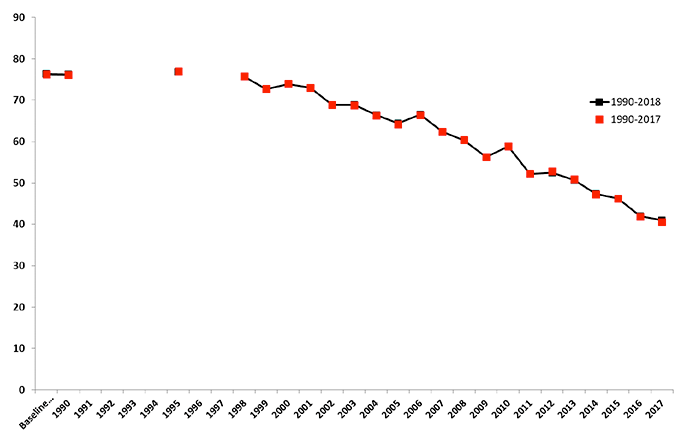
Chart D2 shows revisions to the baseline period. The two inventories are very consistent for the baseline year, with the largest change being 0.04 MtCO2e in the transport sector
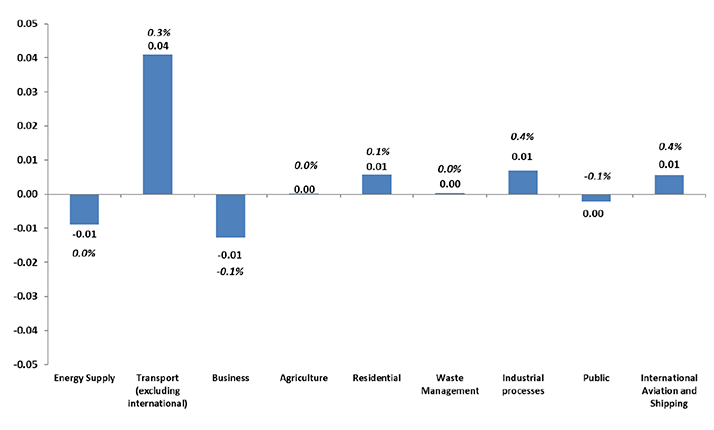
Chart D3 shows revisions to the data for the year 2017, between the two most recent inventories. A large revision can be seen to the Business sector, which is 0.4 MtCO2e (5.0 per cent) higher in the 1990-2018 inventory.
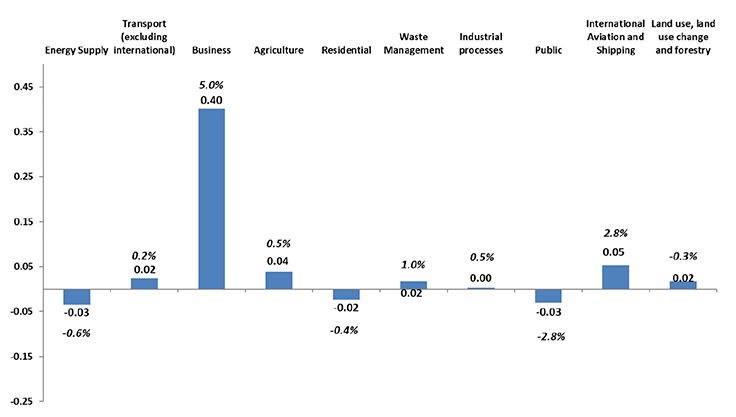
Details of Main Revisions and Interpretation of Revisions to the Inventory
Revisions to emission inventory estimates reflect the continuous development of scientific understanding of emissive processes, and the improvement to underlying data and methods to generate accurate emission estimates; few revisions to the Greenhouse Gas Inventories arise as a result of 'errors' in the popular sense of the word. The compilation of the inventory is governed by a rigorous quality assurance process and is subject to a great deal of third party scrutiny, such as annual reviews by the UNFCCC of the UK inventory.
The latest published Scotland greenhouse gas inventory (currently 1990-2018) represents the best available data at the time and these supersede any previous data, which should be disregarded.
A complete list of the revisions between the previous and latest inventories can be found in the National Atmospheric Emissions Inventory report Greenhouse Gas Inventories for England, Scotland, Wales and Northern Ireland: 1990 - 2018[7]. Details of the most notable revisions are listed below:
As can be seen from chart D2 there was no revisions of note to the baseline year.
Chart D3 shows a notable revision to the business sector relating to 2017, being reported as 0.4 MtCO2e higher in the newer inventory when compared to the older version. This increase can be traced to the IPCC category "1A2c chemicals". Revisions are predominantly due to changes in the UK energy statistics (DUKES). The main issues are large revisions by BEIS in the natural gas use across the chemicals sector during 2016 and 2017, and therefore emissions across all DAs are affected by that change. There are some minor changes also to things like the coal emission factors and small changes to gas oil and fuel oil activity data, but these are in the noise compared to the natural gas revisions.
Interpretation of uncertainties in the inventory
All estimates, by definition, are subject to a degree of statistical 'error' but in this context it relates to the uncertainty inherent in any process or calculation that uses sampling, estimation or modelling.
Estimates of greenhouse gases are compiled by a consortium of contractors. The source emissions are based upon a range of data sources, ranging from model based estimates to point source emission data. As a result, the estimates are subject to a degree of uncertainty. Full analyses of these uncertainties are provided on the National Atmospheric Emissions Inventory website[8].
The Scottish Government commissioned research to overhaul and update the uncertainties model used for the Scottish greenhouse gas inventory. A detailed study was carried out in parallel with the compilation with the 1990-2014 Scottish greenhouse gas inventory to review and improve the uncertainty calculations. A link to this project and to the full report can be found in the Scottish Greenhouse Gas Inventory Uncertainties Project.
Future revisions to the inventory
Every year, greenhouse gas inventories are updated to reflect improvements in the underpinning science, data and modelling which often result in revisions to the entire time series. These revisions also reflect changes to the Intergovernmental Panel on Climate Change (IPCC) guidelines. The Scottish Government is represented at the UK's National Inventory Steering Committee, where improvements to the Scottish and UK inventories are discussed. Some of the changes for the 1990-2018 inventory and for subsequent inventories are already known. However, the exact magnitude and direction of future revisions are not currently clear but on balance we should expect emissions to increase substantially in future inventories.
There are a number of projects underway which might result in considerable revisions for future inventories in a number of sectors. For instance:
- The UK has elected to include the IPCC (2006) Wetlands Supplement as part of their inventory reporting: http://www.ipcc-nggip.iges.or.jp/public/wetlands/. The Wetlands Supplements will estimate the carbon effects of drainage and rewetting peatland[9]. Currently only a very limited subset of wetlands emissions are included in the GHG inventory – mainly peatland extraction activities associated with fuel and horticulture. This revision will include a wider definition, that will more fully capture the effects of Wetlands. At the time of publication, the UK Government has yet to publish a timetable for the incorporation of this expansion to the scope of the inventory.
Charts D5 shows the cumulative effect of revisions to the greenhouse gas inventory from 1990-2008 to the latest 1990-2018 inventory across the time series. Chart D6 shows the cumulative effect of revisions to the Baseline from the 1990-2008 inventory, by source sector.
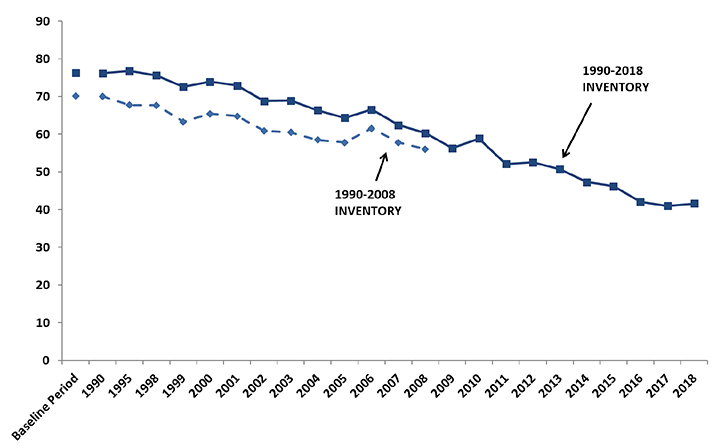
There has been a cumulative upwards revision between 1990-2008 and 1990-2018 across the entire time series. The emissions in the Baseline have been revised upwards by 6.1 MtCO2e (8.7 per cent).
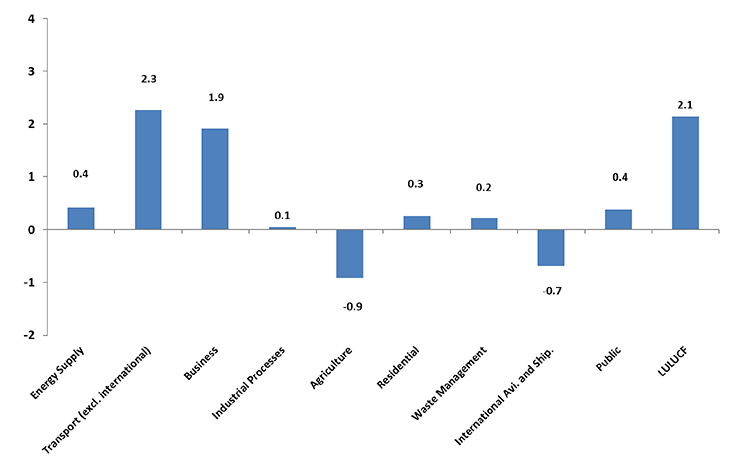
Contact
Email: Andrew.Mortimer@gov.scot
There is a problem
Thanks for your feedback